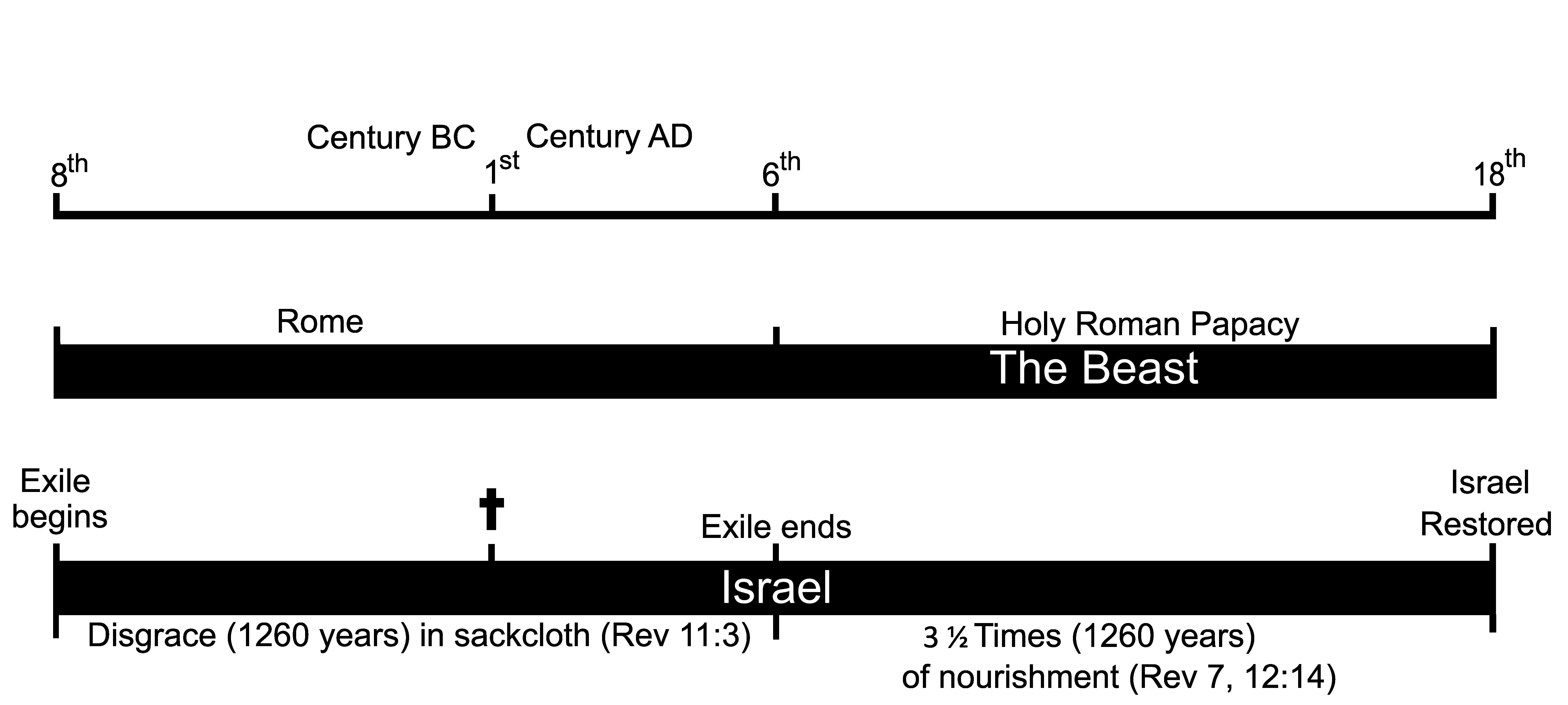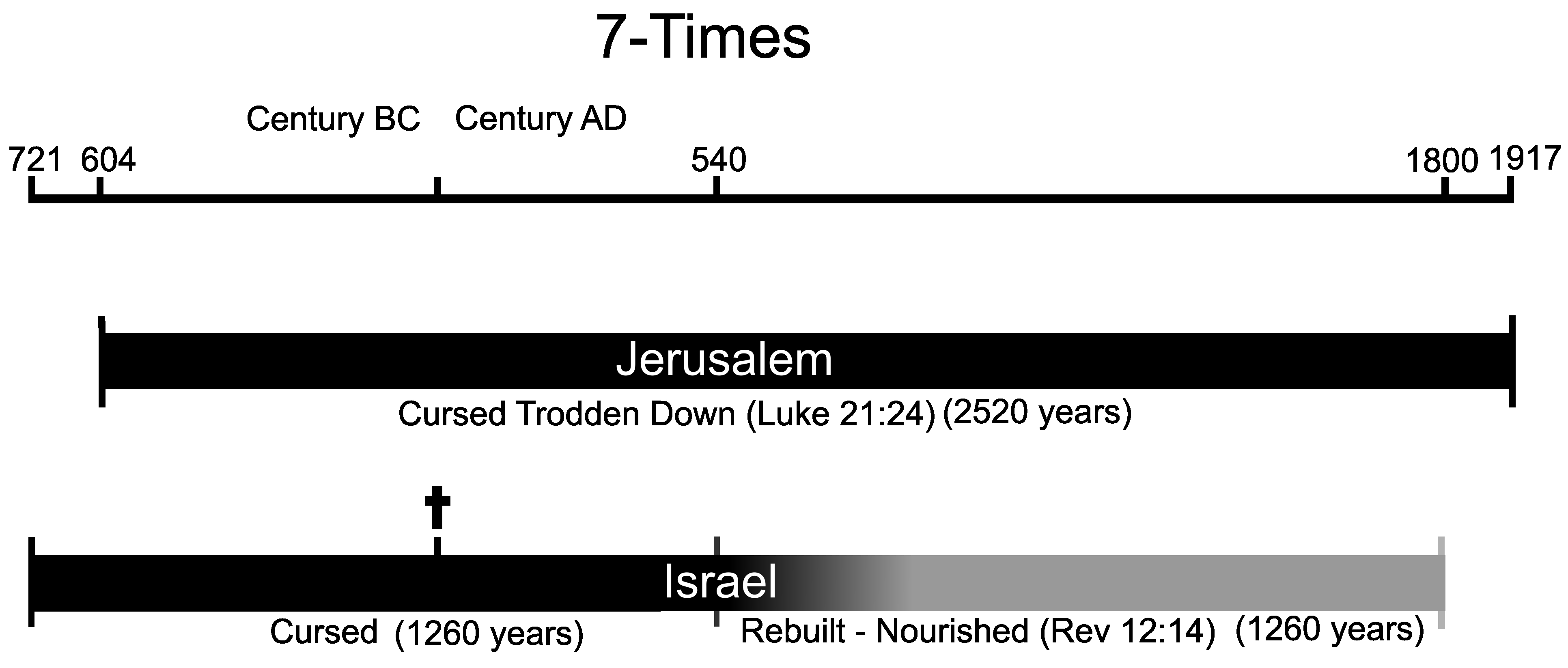Seven times, Time times and half a time, 1260 days, 42 months
In biblical prophecy, time periods such as "seven times," "42 months," "1,260 days," and "time, times, and half a time," found in Leviticus, Daniel, and Revelation, are interconnected to form God's prophetic timeline. These timelines concern Israel, Jerusalem, and the beast - the beast depicted in Revelation and Daniel, work together to illustrate God's sovereignty of judgement and ultimately lead to Israel's restoration throughout human history.
1. "Time, Times, and Half a Time," 1260 Days, and 42 Months
The cryptic phrase “time, times, and half a time” appears in two key passages:
Daniel 7:25: Here, the vision depicts a period of persecution under a blasphemous power, with the saints being handed over to this power for “a time, times, and half a time.”
Revelation 12:14: This passage refers to a woman (interpreted as Israel ) fleeing into the wilderness for “a time, times, and half a time,” where she is protected from the dragon (Satan).
The prophetic time period of 1260 days and 42 months is also mentioned repeatedly in Revelation.
Revelation 13:5-7: The beast was given authority for 42 months to make war with the saints and overcome them.
Revelation 11:2-3: The holy city will be trampled for 42 months, while God’s two witnesses prophesy for 1260 days.
Revelation 12:6: The woman is nourished in the wilderness for 1260 days, corresponding to the protection described in verse 14 (“time, times, and half a time”).
Revelation 12:6 Refers to the same woman as in verse 14, but instead of using the phrase "time, times, and half a time," it mentions that she is nourished in the wilderness for 1,260 days. This suggests that the "time, times, and half a time" is equivalent to the 1,260 days.
The period of 1260 days is equivalent to 3½ years (360 × 3.5). Similarly, 42 months (12 months in a year) is also equal to 3½ years. These time periods represent the same prophetic timeframe.
1,260 / 3½ years = 360 days or 1 year.
1,260 days / 42 months = 30 days or 1 month.
"Time" is understood as one year, "times" as two years, and "half a time" as half a year, leading to a total of 3½ years.
Time = 360 days or 1 year.
Times = 720 days or 2 years.
Half a time = 180 days or half a year.
360 + 720 + 180 = 1,260 days.
2. The "Seven Times" in Leviticus 26
Seven times appears in Leviticus 26, where God warns Israel about the consequences of breaking His covenant. God promises blessings for obedience and curses for disobedience, with "seven times" appearing as a measure of judgement:
Leviticus 26:18: "If after all this you will not listen to me, I will punish you for your sins seven times over."
Leviticus 26:21, 24, 28: God repeatedly warns that persistent rebellion will result in punishment multiplied seven times.
"Seven times" on its own wouldn't have held much significance. It wasn't until the writing of Revelation, where additional details like "time, times, and half a time," 1,260 days, and 42 months were revealed, that “seven times” full meaning became clear.
By examining the time periods in Revelation, where 1,260 days represent 3½ years, we can extrapolate the meaning of "seven times."
3½ times = 1260.
3½ times + 3½ times = 7 times.
7 times = 2520 days or 7 years.
7 x 360 = 2520.
3. A Day for a Year
A key to understanding the above prophetic periods, is the day-year principle. This principle is based on scriptural precedents where one prophetic day equals one literal year. Two main passages support this concept:
Numbers 14:34:"For forty years—one year for each of the forty days you explored the land—you will suffer for your sins."
Ezekiel 4:6: "I have assigned you 40 days, a day for each year."
The timelines themselves also support the idea of a year for a day. If literal days were used, the prophecy would not make sense. For example, Israel was not restored seven years after their captivity began in 740 BC. In 2 Peter 3, Peter told his readers that they still had to wait for the promises of Israel's restoration. Likewise, Jesus indicated that the trampling of Jerusalem would continue, far exceeding seven years after the captivity started.
Additionally, the 49 weeks in Daniel's 70-week prophecy must be understood as a year for a day; otherwise, the timeline would be inconsistent. For more on this, see the article "Daniel’s 70-week Prophecy."
The purpose of Christ's death was to bring forgiveness, and to enable the restoration of the kingdom, and allow God to complete the work He had begun. Israel was still in captivity when Jesus arrived, with the land under Roman control, 720 years after the Assyrian invasion of Israel.
4. The Timelines
The use of "seven times" in Leviticus 26, along with the 1,260 days, 42 months, and "time, times, and half a time" in prophecy, unites to form a cohesive conclusion of God's timeline, completing the work He began in the beginning in the Old testament.
In Revelation 13:5-7, the 42 months (42 x 30 = 1,260 years) represent a period during which the beast, symbolising a corrupt religious-political power, has authority to persecute the saints. Historically, this period is associated with the dominance and oppression of the papal system during the Middle Ages, which was brought to an end by the Napoleonic Wars.

Similarly, Revelation 12:6 and :14 use "1,260 days" and "time, times, and half a time" interchangeably to describe the same period of 1,260 years. This represents a time of protection for the woman from the dragon symbolised by Israel taken to the wilderness with wings of an eagle. Historically, this period corresponds to Israel's migration and eventual establishment in the British Isles, where they were shielded from the influence of the papal power, from 510 to 1800 AD.

The "seven times" in Leviticus 26 represent a timeline of judgement upon Israel and Jerusalem for their disobedience, each spanning 2,520 years but over different periods. These timelines reflect a complete cycle of judgement and restoration, illustrating how God’s justice and mercy unfold over extended periods.
For Israel, this period extends from 721 BC to 1800 AD, with 1800 AD marking the rise of the British Empire. For Jerusalem, it spans from 604 BC to 1917 AD, when British forces liberated Jerusalem from the Turkish Empire.

Conclusion
In conclusion, integrating the biblical time periods of "seven times," "time, times, and half a time," 1,260 days, and 42 months with the day-for-a-year principle creates a unified prophetic timeline that reveals God's overarching plan, showcasing His sovereignty, mercy, and faithfulness, culminating in the eventual restoration of Israel. The convergence of these timelines around 1800 AD is particularly striking, marking a pivotal moment in history with the decline of the beast's power and the rise of God's kingdom through the British Empire. This alignment with historical events highlights the intricate unfolding of God's plan throughout history, providing significant evidence with the scriptures that identifies the lost tribes of Israel as the British Empire. Additionally, the timeline for Jerusalem is significant, as it was the British who liberated the city 2,520 years after the Babylonian invasion, with General Allenby entering Jerusalem in 1917 without firing a shot.
